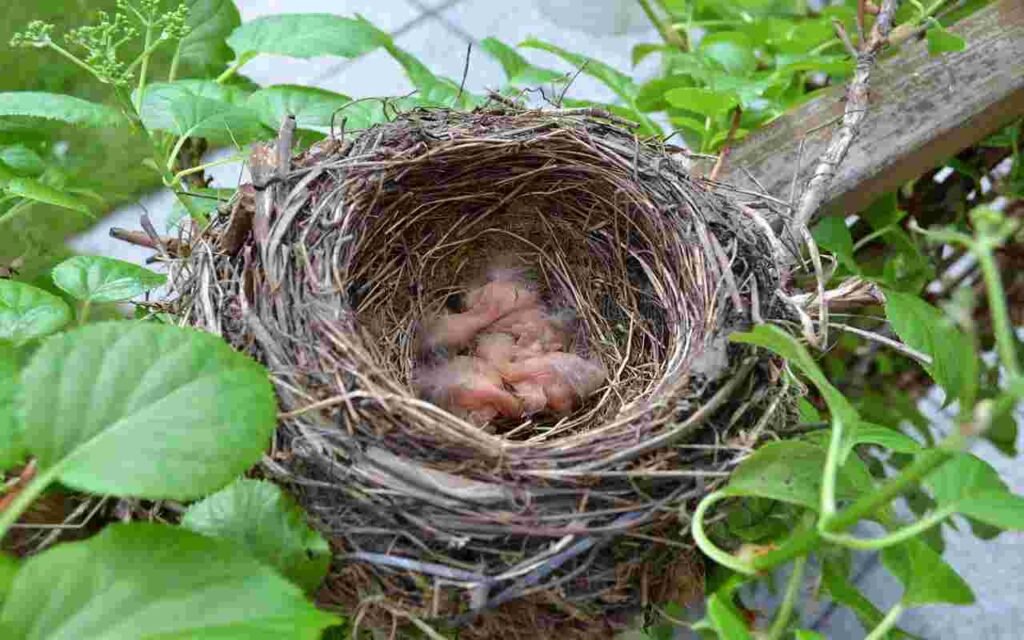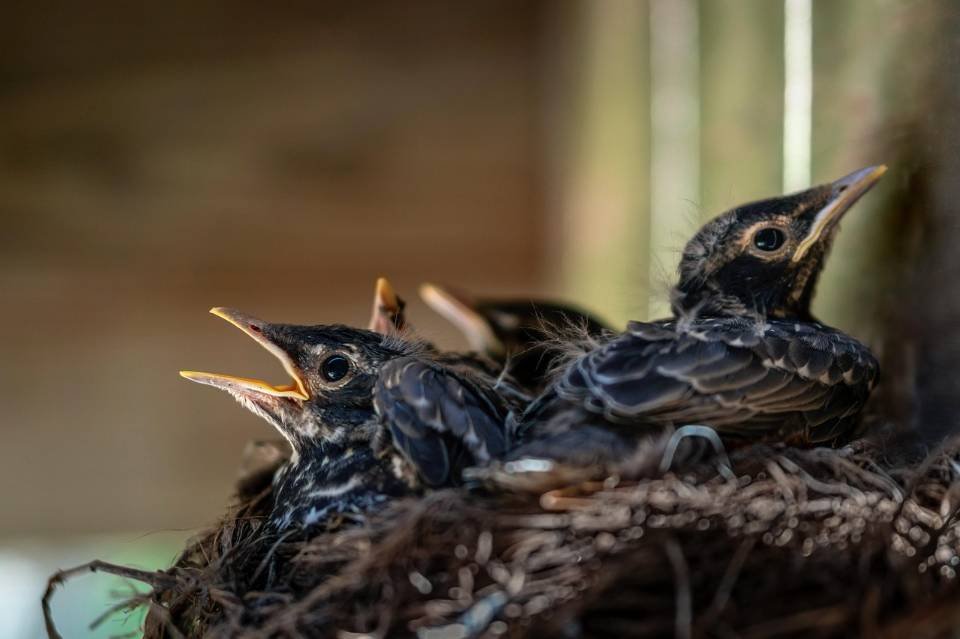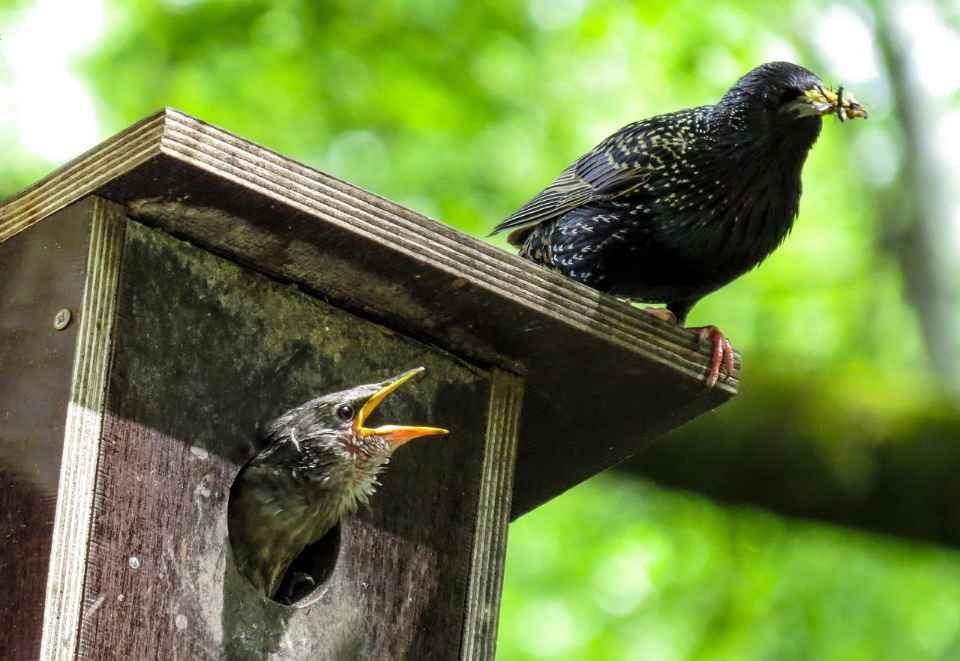You hear those tiny peeps coming from the robin’s nest outside your kitchen window, and suddenly you’re appointed as unofficial neighborhood bird bodyguard. One minute you’re sipping your morning coffee, the next you’re strategizing like a military general about how to protect baby birds from predators 😟. Trust me, I’ve been there.
Last spring, I watched a pair of cardinals build the most adorable nest in my maple tree, only to find it completely ransacked three days later. Feathers everywhere, no babies in sight, and me standing there feeling like I’d failed my feathered friends. That’s when I decided to become serious about protecting baby birds during nesting season.
Spoiler alert: it’s way more complex than just shooing away the neighbor’s cat.
Understanding the Predator Landscape
Let’s talk about who exactly we’re up against here. The world seems designed to make baby birds everyone’s favorite snack, and honestly, it’s pretty brutal out there.
Domestic cats top the predator hit list, and it’s not even close. These fluffy assassins kill billions of birds annually in North America alone. According to the American Bird Conservancy, domestic cats kill an estimated 2.4 billion birds each year in the U.S. Your sweet Whiskers might seem innocent, but those hunting instincts don’t care about your feelings.
Raccoons deserve special mention for being absolute jerks when it comes to protecting nest from raccoons. These masked bandits climb like ninjas and have dexterous little hands perfect for egg-snatching. I’ve seen them systematically destroy entire nest boxes in a single night.
Squirrels can also raid nests and steal eggs or young birds (learn how to keep squirrels away from bird feeders).
Snakes slither into the picture as silent nest raiders. Protecting nest from snakes requires different strategies since they can access places other predators can’t reach. They’re patient, quiet, and surprisingly good climbers.
Don’t forget about aerial threats either. Protecting nest from crows becomes crucial because these intelligent birds actively hunt eggs and nestlings. Hawks, owls, and jays join this airborne danger squad.
Strategic Nest Placement: Location, Location, Location
Want to know the biggest game-changer for protecting baby birds in a nest? Smart placement beats almost every other strategy combined.
Height matters tremendously when positioning nest boxes or choosing natural nesting sites to encourage. Mount boxes at least 5-6 feet high to deter ground predators like cats and raccoons. But don’t go crazy high either; you want accessibility for monitoring and maintenance.
According to NestWatch by the Cornell Lab of Ornithology, nest boxes placed 5–6 feet high and away from trees or structures that predators can use as launch points experience significantly fewer predation events.
Distance from launch pads is crucial. Cats use trees, fences, and structures to leap toward nests. Position nest boxes at least 10 feet from anything a cat could use as a jumping platform. Yeah, they’re basically furry Olympic athletes.
Open sight lines help parent birds spot approaching danger. Dense shrubs might seem protective, but they also provide cover for predators to ambush. I learned this after losing two broods to a neighbor’s cat who figured out the perfect hiding spot.
Baffle placement becomes your secret weapon. These cone-shaped or cylindrical barriers prevent climbing predators from reaching nests. Install them on poles supporting nest boxes, positioning baffles at least 4 feet from the ground.
Designing Predator-Proof Nest Boxes
Building or buying the right nest box makes all the difference in keeping fledglings safe. Generic boxes from big-box stores often fail miserably at predator deterrence.
Entrance hole size determines which birds can enter and which predators get excluded. Smaller holes keep out larger threats while accommodating your target species. A 1.25-inch hole works perfectly for wrens while excluding starlings and most predators.
Predator guards around entrance holes prevent reaching attacks. These metal plates extend the tunnel length, making it impossible for cats, raccoons, or snakes to reach inside. Without guards, predators simply reach through and grab whatever they find.
According to the Cornell Lab of Ornithology’s NestWatch program, installing properly sized entrance holes and metal predator guards can improve nest success, with some species like the Carolina Wren seeing up to a 15.7% increase in survival.
Box depth protects nestlings from reaching predators. Shallow boxes put babies within easy grabbing distance. Deeper boxes with recessed floors keep chicks safely out of reach from most threats.
Drainage and ventilation matter more than you’d think. Poorly designed boxes become death traps during storms or extreme heat, making predator protection pointless. Drill small holes in the floor for drainage and near the top for airflow.
Cat-Specific Protection Strategies
Let’s be real: stopping cats from killing baby birds requires dedicated effort because these predators are relentless and athletic.
Bell collars seem like obvious solutions, but they’re surprisingly ineffective. Cats learn to hunt silently despite bells, and many birds don’t recognize the warning sound anyway. Plus, outdoor cats lose collars frequently.
CatBibs work better than bells by interfering with the pouncing motion cats use to catch birds. These colorful bibs hang from collars and disrupt precise jumping without harming cats.
A study published in Biological Conservation found that CatBib™ collars significantly reduce predation on birds, reptiles, and small mammals, highlighting their effectiveness as a simple, non-invasive solution. I’ve seen dramatic reductions in bird kills when neighbors use these consistently.
Motion-activated sprinklers create exclusion zones around vulnerable areas. Cats hate unexpected water sprays and quickly learn to avoid protected zones. Position sprinklers to cover nest areas and bird feeding stations.
Physical barriers like pruning guards or wire cages protect specific nests without restricting parent access. These temporary solutions work great for ground-nesting birds or low shrub nests.
Dealing with Raccoon Raiders
Protecting nest from raccoons requires understanding their incredible problem-solving abilities and dexterity. These guys make cats look like amateurs.
Pole-mounted nest boxes with proper baffles stop most raccoon attacks. But ensure poles are smooth metal; raccoons climb textured surfaces easily. I watched one climb a rough wooden post like it had built-in ladder rungs.
Hardware cloth barriers create effective raccoon-proof zones around ground nests or low shrubs. Use 1/4-inch mesh because raccoons can reach through larger openings. Secure barriers firmly; raccoons will test every weak point.
Electric fencing works fantastically for protecting larger nesting areas. Low-voltage wildlife fences deliver harmless but memorable shocks that teach raccoons to avoid treated areas. This solution works especially well for ground-nesting species.
Timing matters with raccoon deterrence. These nocturnal hunters are most active just after sunset and before sunrise. Focus protection efforts during these peak hunting times.
Snake Prevention Techniques
Protecting nest from snakes challenges even experienced birders because these predators access nests in ways other threats cannot.
Smooth metal poles prevent most snake climbing attempts. Snakes need textured surfaces for grip, so ultra-smooth surfaces become impassable barriers. PVC pipe also works but looks less attractive in landscapes.
Snake guards specifically designed for nest poles create additional climbing obstacles. These inverted cones or cylinders prevent snakes from wrapping around poles for climbing leverage. According to NestWatch, snake guards and smooth poles are among the most reliable physical methods to prevent snakes from accessing bird nests.
Ground clearance eliminates snake hiding spots near nest areas. Keep grass short and remove brush piles or debris where snakes might conceal themselves before attacking.
Chemical deterrents like sulfur or mothballs get recommended frequently, but they’re largely ineffective and potentially harmful to birds. Stick with physical barriers for reliable snake protection.
Protecting Ground Nesters and Fledglings
Keeping fledglings safe presents unique challenges since these awkward teenagers can’t fly well but insist on leaving nests anyway.
Temporary fencing around known ground-nesting areas helps exclude predators during critical periods. Use lightweight materials that won’t harm birds but deter four-legged threats.
Dense shrub plantings provide natural escape cover for fledglings learning to fly. Choose native plants with thorny or dense branching patterns that create predator barriers while offering food sources.
Staged feeding helps fledglings develop flight skills safely. Parents continue feeding recently fledged birds, so maintaining predator-free zones near nests keeps families together during this vulnerable period.
Minimize disturbance during fledging season. Human activity can panic young birds into premature flight attempts, making them easy targets for waiting predators.
Protecting Eggs and Chicks During Peak Season
Protecting eggs and chicks requires different strategies than defending older nestlings because these babies can’t move or escape threats.
Monitoring schedules help track nesting progress without causing abandonment. Check nests quickly and infrequently during egg-laying and early incubation periods. Stressed parents may abandon nests entirely.
Decoy nests sometimes redirect predator attention away from active nests. Place obvious fake nests with decoy eggs in areas where predators will find them easily, hopefully satisfying their hunting drive.
Scent masking reduces mammalian predator detection of nests. Avoid handling nest materials or areas around active nests since human scent can attract curious predators.
Weather protection becomes crucial during storms when parents can’t adequately shelter eggs or young chicks. Temporary covers or windbreaks help families survive severe weather that would otherwise result in nest failure.
Technology and Modern Solutions
IMO, combining traditional methods with modern technology creates the most effective bird protection during nesting season.
Trail cameras help identify specific predators targeting your nests. Knowing whether you’re dealing with cats, raccoons, or other threats allows targeted countermeasures rather than generic approaches.
Smart sprinkler systems can be programmed to activate during peak predator activity times. Some systems include smartphone apps for remote monitoring and control.
Ultrasonic deterrents claim to repel various predators, but results vary dramatically. These devices work better for some species than others, and many animals habituate quickly to constant sounds.
Solar-powered lights with motion sensors can startle nocturnal predators and make them seek easier targets elsewhere.
When Intervention Goes Too Far
Here’s something most people don’t consider: sometimes our protection efforts actually harm the birds we’re trying to help.
Over-protection can prevent normal parent-chick interactions necessary for proper development. Young birds need to experience some level of natural stress to develop appropriate fear responses and survival skills.
Habitat modification taken too far eliminates beneficial insects and food sources that birds need. Sterile landscapes might exclude predators but also eliminate the biodiversity that supports healthy bird populations.
Dependency creation happens when birds become too reliant on human-provided protection. Birds that never learn natural predator avoidance often fail when they encounter threats outside protected areas.
The goal is supporting natural processes, not replacing them entirely.
Legal and Ethical Considerations
FYI, protecting native birds involves legal responsibilities many people don’t realize. The Migratory Bird Treaty Act protects most North American bird species, making it illegal to disturb nests, eggs, or nestlings without permits.
According to a U.S. Senate report on the Migratory Bird Treaty Act, violations can result in fines or criminal penalties, highlighting the importance of following legal guidelines when protecting nests.
Active nest protection is generally legal and encouraged, but removing predators often requires special considerations. Killing or relocating native predators like hawks or snakes typically violates wildlife protection laws.
Non-native species like European starlings and house sparrows don’t receive the same legal protections, but ethical considerations still apply when managing these populations.
Always check local regulations before implementing predator control measures that might affect protected species.
Building a Bird-Safe Ecosystem
The most effective long-term approach involves creating environments where birds can thrive naturally rather than constantly battling individual predators.
Encouraging birds to nest in your garden starts with smart habitat design.
Native plant landscaping provides food sources, nesting materials, and natural predator deterrence through thorny or dense growth patterns. Native plants also support the insect populations that feed baby birds (learn more about bird-friendly garden design).
Water features attract birds while providing opportunities to observe nesting behaviors and predator interactions. Strategic placement of birdbaths or fountains can influence where birds choose to nest.
Community involvement amplifies individual protection efforts. Neighbor cooperation in cat management and habitat improvement benefits entire bird populations rather than just isolated nests.
Remember, healthy ecosystems balance predator and prey relationships naturally. Our job involves tipping the scales slightly in favor of species that face modern challenges like habitat loss and introduced predators 🙂
The satisfaction of watching a successful fledging makes all the effort worthwhile. Last summer, I watched five baby cardinals successfully leave the nest I’d spent weeks protecting. Seeing them hop around the yard with their parents, gradually building confidence and flight skills, reminded me why this protection work matters so much.
Your backyard birds face enough challenges without preventable predation adding to their struggles. With smart strategies and consistent effort, you can help tip the odds in their favor during those critical nesting months.




